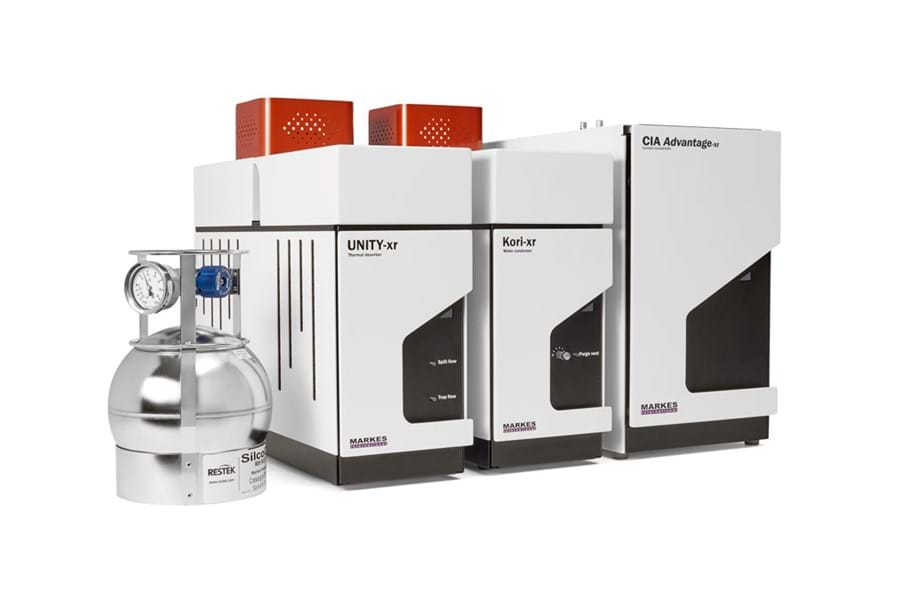OTM-50 is an analytical method from the US EPA for monitoring volatile fluorinated compounds (VFCs) in stationary sources. Air samples are collected in canisters and analysed using thermal desorption coupled with gas chromatography–mass spectrometry (TD–GC–MS).
 The destruction of perfluoroalkylated and polyfluoroalkylated substances (PFAS) is a vital step in global efforts to reduce their ongoing impact on human health and environment. However, if the destruction process used doesn’t completely mineralise the PFAS, lower-molecular-weight volatile fluorinated compounds (VFCs) may be released into the environment.
The destruction of perfluoroalkylated and polyfluoroalkylated substances (PFAS) is a vital step in global efforts to reduce their ongoing impact on human health and environment. However, if the destruction process used doesn’t completely mineralise the PFAS, lower-molecular-weight volatile fluorinated compounds (VFCs) may be released into the environment.
OTM-50 is one of two “Other Test Methods” published by the US EPA for monitoring fluorinated substances in air, and focuses on VFCs (the other method is OTM-45, and applies to PFAS themselves). OTM-50 was written to enable monitoring of PFAS destruction and mitigate risks from the release of VFCs. It can also be applied to testing of industrial emissions and air monitoring applications more broadly.
What are the key challenges for VFC analysis?
The instrumentation and consumables used for VFC analysis need to be considered carefully. Particular analytical challenges are:
- Incredibly volatile compounds, which are not catered for by standard analytical system configurations and methods
- High humidity, which can negatively impact repeatability and the long-term functioning of the analytical system
- Varying CO2 levels, which can be very high (up to 15% has been reported), leading to bias and preventing quantitative reporting of some compounds.
Markes’ approach to tackling these challenges are outlined below.
Can the most volatile species in OTM-50 be reliably monitored on a single system?
OTM-50 lists 30 VFCs that are “products of incomplete destruction” of larger PFAS species. They are all fully fluorinated, with a C1–C8 framework, and include known degradation products such as Fluoroether E-1 (which results from degradation of GenX).
Tetrafluoromethane (CF4, Freon 14) is the most difficult compound to monitor from the list and is also one of the most important. CF4 is a potent greenhouse gas with a global warming potential that is 50,000 times greater than CO2, and is produced when mineralisation of other PFAS is not complete.
CF4 is difficult to trap even with the strongest sorbents because of its high volatility (b.p. –128°C). However, the backflush design of the focusing trap in Markes’ UNITY-xr instrument means that it can be captured at –30°C in sample volumes up to 25 mL without breakthrough.
The other 29 compounds have retention volumes of over 1 L, giving the analyst the flexibility to meet the limits of detection needed. For example, running the same sample twice but with different volumes ensures that all 30 components can be quantified under the conditions that generate the most reliable results
How can water management for OTM-50 help to improve results?
The presence of humidity in a sample can reduce retention time stability, speed up degradation of the GC column phase, cause split discrimination upon injection, and result in a rapid decline in MS sensitivity. When trapping at sub-zero temperatures (which is required for OTM-50), humid samples can also result in ice formation within the focusing trap, resulting in poor reproducibility and potentially causing damage to the analytical system.
In a typical OTM-50 protocol, some water will be removed within the sample train prior to transfer into the canister, but the relative humidity can still remain very high. However, with Markes’ analytical system for OTM-50, the residual water in the sample is removed using the Kori-xr water management module, avoiding any negative impact on results.
How can high-CO2 samples be successfully managed within OTM-50?
The high levels of CO2 that can be present in stationary sources can result in severe chromatographic interference (especially for C2F6, with which CO2 co-elutes), decreasing the sensitivity of the analysis.
Samples can be diluted prior to analysis to manage the concentration of CO2, but on its own this is insufficient to resolve the above issues. Therefore, in Markes’ analytical system for OTM-50, the sample, once collected on the focusing trap, is purged at a slightly elevated temperature, prior to the main desorption step. This significantly reduces the levels of CO2, negating chromatographic interference of key species (C2F6) and enabling quantitation.
Choosing the best system for VFC analysis by OTM-50
Markes International’s UNITY–CIA Advantage-xr system is uniquely placed to help analysts navigate the challenges posed by OTM-50.
Key features are:
- A cryogen-free, backflushed focusing trap that enables even the most volatile compounds listed in OTM-50 to be analysed.
- A Kori-xr water-removal module, which makes it easy to remove excess humidity, reducing the risk of negative impacts on the analysis or the instrumentation.
- An elevated-temperature trap purge that removes excess CO2, avoiding bias in the analysis.

Relevant products
Relevant Products |
|---|
What compounds are included in OTM-50?
The 30 compounds specified in OTM-50 are listed below, in order of decreasing volatility.
Name |
CAS No. |
Molecular formula |
|---|---|---|
Carbon tetrafluoride |
75-73-0 |
CF4 |
Hexafluoroethane (FC-116) |
76-16-4 |
C2F6 |
Tetrafluoroethene |
116-14-3 |
C2F4 |
Trifluoromethane (HFC-23) |
75-46-7 |
CHF3 |
Octafluoropropane |
76-19-7 |
C3F8 |
Difluoromethane (HFC-32) |
75-10-5 |
CH2F2 |
Fluoromethane (HFC-41) |
593-53-3 |
CH3F |
Pentafluoroethane (HFC-125) |
354-33-6 |
C2HF5 |
Hexafluoropropene |
116-15-4 |
C3F6 |
Hexafluoropropene oxide (HFPO) |
428-59-1 |
C3F6O |
Decafluorobutane |
355-25-9 |
C4F10 |
Dodecafluoropentane |
678-26-2 |
C5F12 |
Tetradecafluorohexane |
355-42-0 |
C6F14 |
1H-Perfluoropentane |
375-61-1 |
C5HF11 |
Hexadecafluoroheptane |
335-57-9 |
C7F16 |
Heptafluoropropyl-1,2,2,2-tetrafluoroethyl ether (E1) |
3330-15-2 |
C5HF11O |
1H-Perfluorohexane |
355-37-3 |
C6HF13 |
1H-Perfluoroheptane |
375-83-7 |
C7HF15 |
2H-Perfluoro-5-methyl-3,6-dioxanonane (E2) |
3330-14-1 |
C8HF17O2 |
1H-Perfluorooctane |
335-65-9 |
C8HF17 |
Octadecafluorooctane |
307-34-6 |
C8F18 |
1H-Nonafluorobutane |
375-17-7 |
C4HF9 |
1H-Heptafluoropropane |
2252-84-8 |
C3HF7 |
1,1,1,2-Tetrafluoroethane (HFC-134a) |
811-97-2 |
C2H2F4 |
1,1,1-Trifluoroethane (HFC-143a) |
420-46-2 |
C2H3F3 |
Chlorodifluoromethane (HCFC-22) |
75-45-6 |
CHClF2 |
Chlorotrifluoromethane (CFC-13) |
75-72-9 |
CF3Cl |
Octafluorocyclobutane (FC-C318) |
115-25-3 |
C4F8 |
Octafluorocyclopentene (FC-C1418) |
559-40-0 |
C5F8 |
Trichloromonofluoromethane (CFC-11) |
75-69-4 |
CCl3F |






